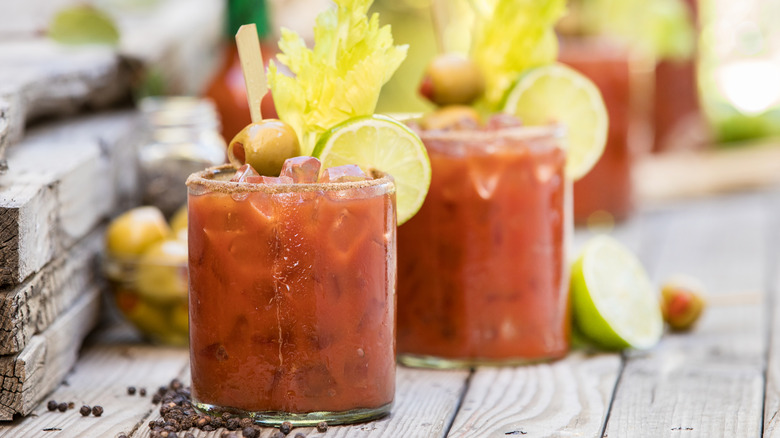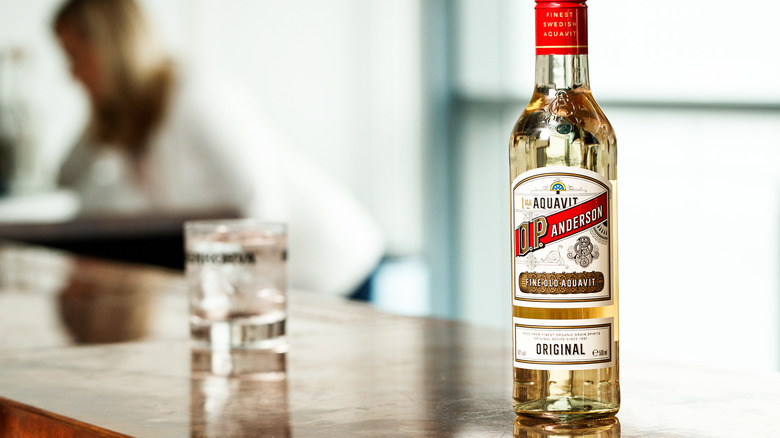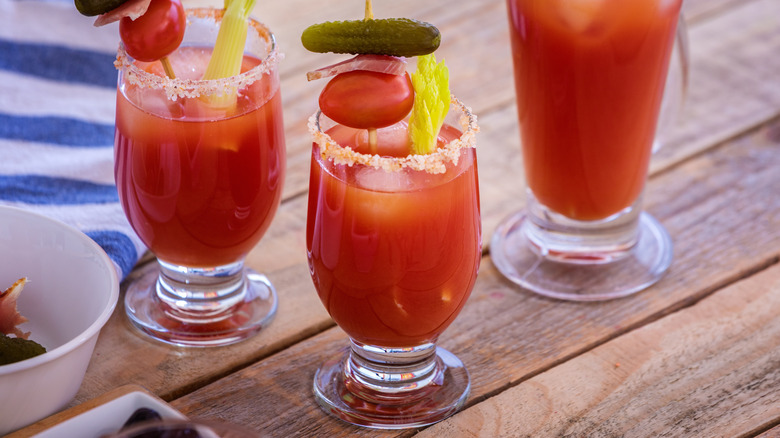Why You Should Be Using Aquavit For A Better Bloody Mary
Nothing cures what's ailing you like a bloody mary in the morning — especially if what's ailing you is the aftermath of drinking the night before. The bloody mary is an iconic cocktail that everyone seems to have their own version of, although most variations typically use vodka as the spirit of choice. The next time you want to concoct the perfect bloody mary, try swapping regular old vodka for the herbaceous Scandinavian liquor aquavit. It'll elevate this classic from regular brunch fare to a complex, botanical dream.
Aquavit is similar to gin in that it's a neutral grain alcohol infused with botanicals; in this case, savory, earthy caraway, and dill. Adding aquavit to your bloody mary will pair beautifully with the tanginess of the tomato juice and the peppery greenery of both celery salt and stalk. It's relatively mellow, but still more flavorful than vodka, and once you taste it in a bloody mary, you'll wish you'd known about it sooner.
The flavor profile of aquavit varies by region
Aquavit is the national liquor of Scandinavia — in fact, it's so beloved that it's believed to have healing qualities. The word aquavit literally means "water of life," and it was used as a curative during the Black Death. While it probably didn't have much effect on the bubonic plague, at least it lifted the spirits of people during one of the darkest, most depressing periods in European history?
While Americans have been using aquavit in cocktails (like the French 75 and negroni) for a while now, the liquor is particularly suited to bloody marys because it's crafted to complement pungent Nordic flavors such as pickled herring and ripe cheeses. Do you think it's going to fold when put up against even the most assertive bloody mary additives, like anchovy paste or horseradish? Not a chance. Aquavit's flavorings depend on the region, so it's a good idea to familiarize yourself with the different styles: the Danes are fond of dill, coriander, and caraway; the Swedes prefer fennel; while Norwegians opt for something altogether more aromatic, using adjuncts like star anise and citrus peel, and aging their aquavit in oak sherry barrels. While a good Norwegian aquavit would serve as a delightful aperitif, its flavor profile might actually make for an unusual bloody mary.
Bloody botanicals at home
If you want to elevate your bloody mary game, there are a few tips to keep in mind beyond including aquavit. The first is to use high-quality tomato juice; if you're not juicing tomatoes yourself, ensure you're using tomato juice with decent viscosity, and avoid any watered-down varieties. Also, don't over-shake the bloody mary; you may even opt for stirring. When adding aquavit, treat it just as you would vodka in your bloody mary recipe. To prevent diluting the aquavit's flavor, be sure to use molded ice blocks instead of freezer ice, as the latter can dilute and damage the flavor and texture of both the spirit and the bloody mary mix (this is another reason to avoid shaking).
Get creative with your aquavit bloody mary garnishes — the liquor's unique flavor profile can inspire more interesting additions. Pickled okra or onions would pair beautifully with the dill-and-coriander-inflected Danish aquavit, while its caraway flavors will complement the tomato juice nicely. If you're trying Swedish aquavit, consider what best accompanies its licorice profile: perhaps a spicy red chili salt rim, for example, or an emphasis on celery (whether seed, stalk, or salt). A splash of lemon juice would add brightness, and a hint of anchovy paste would add a delightful umami kick.


